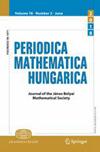包含两类污染的运行极限定理
IF 0.5
3区 数学
Q3 MATHEMATICS
引用次数: 0
摘要
本文研究了具有三种结果的试验序列。这些结果被标记为成功、I 型失败和 II 型失败。如果一个序列中最多包含一次 I 型失败和一次 II 型失败,那么这个序列就被称为 "最多(1+1)污染 "序列。由此可以得到最长的最多(1+1)次污染运行的长度分布。证明基于 Csáki、Földes 和 Komlós 的一个强大的lemma。除了数学证明外,还给出了支持我们定理的模拟结果。本文章由计算机程序翻译,如有差异,请以英文原文为准。

A limit theorem for runs containing two types of contaminations
In this paper, sequences of trials having three outcomes are studied. The outcomes are labelled as success, failure of type I and failure of type II. A run is called at most \(1+1\) contaminated, if it contains at most one failure of type I and at most one failure of type II. The accompanying distribution for the length of the longest at most \(1+1\) contaminated run is obtained. The proof is based on a powerful lemma of Csáki, Földes and Komlós. Besides a mathematical proof, simulation results supporting our theorem are also presented.
求助全文
通过发布文献求助,成功后即可免费获取论文全文。
去求助
来源期刊
CiteScore
1.40
自引率
0.00%
发文量
67
审稿时长
>12 weeks
期刊介绍:
Periodica Mathematica Hungarica is devoted to publishing research articles in all areas of pure and applied mathematics as well as theoretical computer science. To be published in the Periodica, a paper must be correct, new, and significant. Very strong submissions (upon the consent of the author) will be redirected to Acta Mathematica Hungarica.
Periodica Mathematica Hungarica is the journal of the Hungarian Mathematical Society (János Bolyai Mathematical Society). The main profile of the journal is in pure mathematics, being open to applied mathematical papers with significant mathematical content.

 求助内容:
求助内容: 应助结果提醒方式:
应助结果提醒方式:


